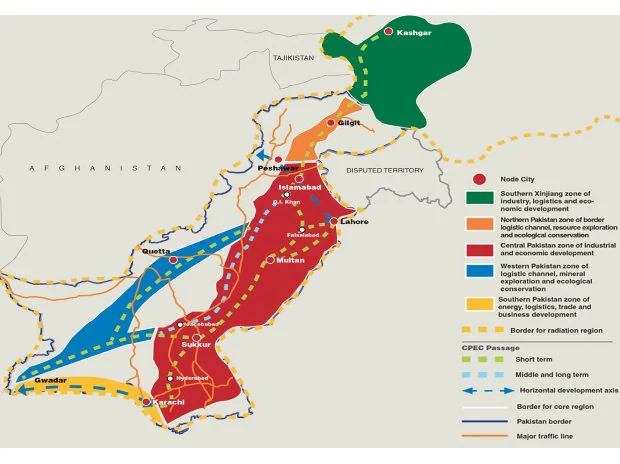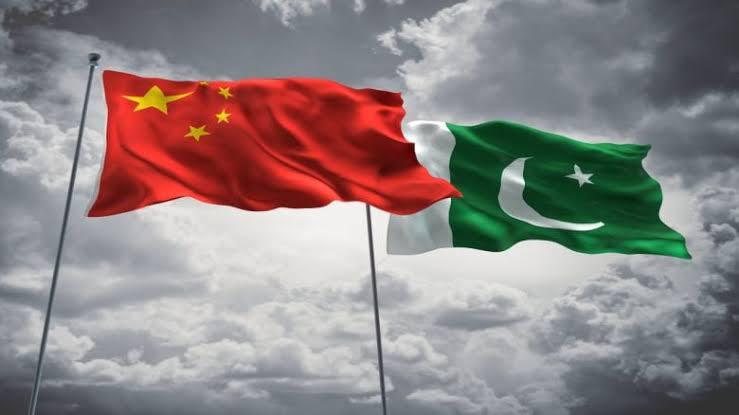 CPEC News
CPEC News
I. Defining the CPEC: Understanding its Essence
– Definition .
The China-Pakistan Economic Corridor (CPEC) is a powerful partnership aiming for growth, development, and prosperity. It encompasses extensive transportation connections, industrial collaboration, economic development, and cultural exchange. Through impactful infrastructure projects, industrial growth, and improved livelihoods, CPEC is propelling socio-economic development, regional prosperity, and security.
– CPEC coverage.
The China-Pakistan Economic Corridor (CPEC) encompasses China’s Xinjiang Uygur Autonomous Region and the entire territory of Pakistan. The corridor is divided into two key areas, namely the core zone and the radiation zone, to aptly represent the scale, scope, and arrangement of the construction and development. This strategic initiative facilitates enhanced economic connectivity and fosters collaboration between China and Pakistan.
– Key nodes.
The node cities that the corridor passes through include Kashgar, Atushi, Tumshuq, Shule, Shufu, Akto, Tashkurgan Tajik, Gilgit, Peshawar, Dera Ismail Khan, Islamabad, Lahore, Multan, Quetta, Sukkur, Hyderabad, Karachi and Gwadar.

– Spatial layout.
The China-Pakistan Economic Corridor (CPEC) comprises a core zone and a radiation zone, forming a spatial layout known as “one belt, three axes, and several passages”. The “one belt” refers to the belt area, encompassing the core zone of CPEC, which includes Kashgar, Tumshuq City, Atushi City, and Akto county in Kizilsu Kirghiz autonomous prefecture of Xinjiang, China, as well as Islamabad and various parts of Punjab, Sindh, Khyber-Pakhtunkhwa, Balochistan, AJK, and Gilgit-Baltistan.
Furthermore, the “three axes” represent three horizontal axes connecting Lahore and Peshawar, Sukkur and Quetta, and Karachi and Gwadar. Lastly, the “several passages” refer to a network of railways and highway trunk lines that facilitate transportation from Islamabad to Karachi and Gwadar.
The CPEC’s strategic layout enables efficient connectivity and trade opportunities between China and Pakistan. By implementing infrastructure projects and operationalizing transportation routes, the CPEC aims to boost regional economic integration and uplift the socio-economic growth of both countries.
With careful planning and collaborative efforts, the CPEC strives to create a pathway for mutual prosperity and development.
– Key functional zones.
The China-Pakistan Economic Corridor (CPEC) encompasses several functional zones, spanning from north to south. These zones include the Xinjiang foreign economic zone, northern border trade logistics and business corridor along with an ecological reserve, the eastern and central plain economic zone, the western logistics corridor business zone, and the southern coastal logistics business zone. These zones serve as hubs for node cities, transportation corridors, and industrial clusters, thus driving economic development and fostering regional connectivity.
II. Basic Conditions
China-Pakistan cooperation on economic and social development has made remarkable progress. China-Pakistan trade has experienced rapid growth in the past five years, with an impressive annual growth rate of 18.8% on average. Bilateral investment has also soared, making China the largest source of foreign capital for Pakistan. Moreover, international economic and technological cooperation has gained strong momentum, expanding into diverse areas and reaching new heights. Notably, social and people-to-people exchanges have been on the rise, further enhancing bilateral ties. By leveraging their respective comparative advantages and fostering all-round cooperation through the physical Corridor, China and Pakistan are poised to elevate their economic partnership to unprecedented heights.
There is a huge potential for China and Pakistan to strengthen cooperation based on complementary resources. China and Pakistan possess distinct natural resources and are in varying stages of economic development, industrialization, and urbanization. China excels in infrastructure construction, high-quality production capacity in equipment manufacturing, iron & steel, and cement industries, as well as financing for investment. On the other hand, Pakistan boasts abundant human and natural resources, immense potential for economic growth, and extensive market prospects, all complemented by its strategic geographic location. The China-Pakistan Economic Corridor (CPEC) facilitates the orderly and timely flow of economic factors between the two countries. By leveraging this corridor, resource allocation efficiency will be significantly improved, allowing each country to fully harness their comparative advantages. This collaboration promises to be a game-changer, unlocking opportunities and propelling economic growth in both nations.
West China has entered into a new historic phase of economic and social development. Since the implementation of the western development strategy, West China, particularly Xinjiang, has experienced remarkable economic and social progress. The region has witnessed a significant increase in economic strength, thanks to improved infrastructure and enhanced livelihood opportunities for its people. Notably, Kashgar, a major city in Xinjiang, has embraced rapid economic and social development, positioning itself as a gateway to the outside world. The infrastructural advancements along the route from Kashgar to Khunjerab Pass have laid the groundwork for facilitating and fostering China-Pakistan economic and trade exchange on land.
Pakistan has the potential to grow into a “tiger of Asia”. Pakistan is blessed with abundant natural resources and a vast domestic market. It holds a strategic position at the crossroads of South Asia, China, and Central Asia. This unique location offers immense opportunities for geo-economic cooperation and development through enhanced regional connectivity. To realize this vision, extensive consensus has been reached on Vision 2025. This comprehensive plan aims to strengthen public governance, reinforce infrastructure construction, and harness the demographic dividend. These efforts will help accumulate human and social capital, elevate industrialization, and foster a competitive knowledge-based economy.
III. Opportunities
The world economy is recovering and the external environment is favorable. The world economy is anticipated to embark on a new phase of growth, marking a significant turnaround after years of recession and adjustments since the last global financial crisis. This positive trend sets the stage for major collaborative projects between China and Pakistan, benefiting from a more flexible investment and financing environment. Moreover, the enhanced market conditions for their industrial cooperation and the growing opportunities for international community participation in the CPEC building make it an enticing prospect for neighboring countries to reap the rewards.
The CPEC is closely associated with the implementation of the Belt and Road Initiative. The CPEC, as a pilot project of the Belt and Road Initiative, holds valuable experience that can be shared with other countries along the Belt and Road. The fusion of national development strategies facilitates policy coordination between China and Pakistan. Their close proximity benefits infrastructure connectivity, while their coordinated economic and trade strategies promote seamless trade. With highly complementary investment and financing, financial integration becomes more feasible. Furthermore, the enduring strategic friendship between these two nations fosters strong people-to-people bonds.
The macro economy in Pakistan has been much improved. Pakistan has achieved widespread consensus on social stability, economic development, and livelihood improvement. This has paved the way for a series of effective economic reforms to take place, with the country capitalizing on its advantages, such as a young and dynamic workforce. In recent years, Pakistan’s macro economy has witnessed significant improvements. Economic growth has gained momentum, resulting in increased demand for transportation and energy. Major projects associated with the China-Pakistan Economic Corridor (CPEC) have experienced favorable conditions, attracting higher expected returns. Additionally, Pakistan’s international balance of payments has moved closer to equilibrium, leading to stable foreign exchange reserves and exchange rate expectations. As a result, the investment and financing risks for major CPEC projects have diminished. The current macroeconomic environment presents an unprecedented opportunity for the successful implementation of the CPEC initiative.
IV. Possible Challenges
- Geopolitical and security risks. The geopolitical environment in South Asia is known for its inherent instability. The adjustment of world powers’ policies towards this region adds to the uncertainty. This mix of international, regional, national, and extremist factors can lead to disruptive activities, posing a threat to the security of the CPEC building. It is crucial to understand and navigate these challenges to ensure a stable and secure future in the region.
- The restraints of natural and geographical factors. Southern Xinjiang in China faces challenges due to its weak industrial base and limited economic scale. The China-Pakistan border area, with its unique natural and geographical conditions, incurs high costs in the construction, operation, and management of major infrastructure projects. In contrast, the Indus River valley in Pakistan displays relatively advanced economic development, but is constrained by high population density and limited resource-carrying capacity. On the other hand, the western area is underdeveloped and grapples with harsh natural conditions.
- Restraints to economic growth prospects. Pakistan must confront significant obstacles to economic and social development in order to maintain its economic growth momentum. These challenges include deficiencies in energy, infrastructure, administration, and governance, as well as regional economic and social imbalances and vulnerabilities in the external sector. It is crucial to closely monitor these issues to ensure the success of the China-Pakistan Economic Corridor (CPEC) and mitigate any potential challenges it may face.

